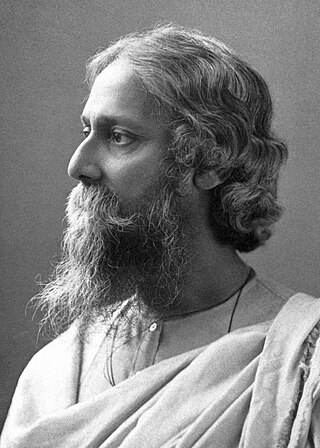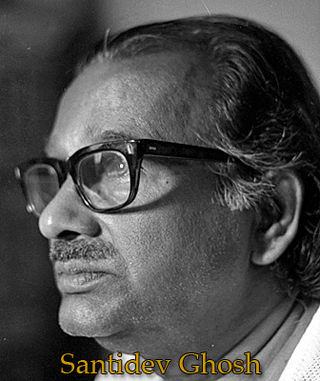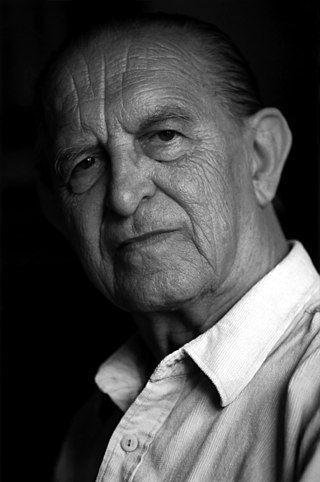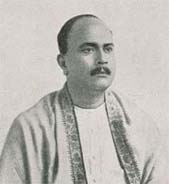Related Research Articles

Abanindranath Tagore was the principal artist and creator of the "Indian Society of Oriental Art". He was also the first major exponent of Swadeshi values in Indian art. He founded the influential Bengal school of art, which led to the development of modern Indian painting. He was also a noted writer, particularly for children. Popularly known as 'Aban Thakur', his books Rajkahini, Buro Angla, Nalak, and Khirer Putul were landmarks in Bengali language children's literature and art.
South Asian literature refers to the literature that is composed by authors in the Indian subcontinent and its diaspora. It has an extensive history with some of the earliest known pieces of literature. South Asia has many different languages that have been spoken due to its size and how long people have been inhabiting it. This has caused the region to be the most linguistically diverse region in the planet, and as well as having four language families, hundreds of languages and thousands of dialects. Many modern pieces of South Asian literature are written in English for a global audience. Many of the ancient texts of the subcontinent have been lost due to the inability to preserve verbally transmitted literature. South Asia has many significant authors that shaped the postcolonial period and response to the British establishment in the subcontinent. Modern South Asian literature has a deep focus on independence from Britain, mainly expressed in prose, this literature commonly discusses the partition of India and how different South Asian nations, religions, and cultures interact with each other. Countries to which South Asian literature's writers are linked include India, Pakistan, Bangladesh, Sri Lanka and Nepal. Works from Bhutan, Myanmar, Tibet, and the Maldives are sometimes also included.

The Bengal Renaissance, also known as the Bengali Renaissance, was a cultural, social, intellectual, and artistic movement that took place in the Bengal region of the British Raj, from the late 18th century to the early 20th century. Historians have traced the beginnings of the movement to the victory of the British East India Company at the 1757 Battle of Plassey, as well as the works of reformer Raja Rammohan Roy, considered the "Father of the Bengal Renaissance," born in 1772. Nitish Sengupta stated that the movement "can be said to have … ended with Rabindranath Tagore," Asia's first Nobel laureate.
Indian English literature (IEL), also referred to as Indian Writing in English (IWE), is the body of work by writers in India who write in the English language but whose native or co-native language could be one of the numerous languages of India. Its early history began with the works of Henry Louis Vivian Derozio and Michael Madhusudan Dutt followed by Rabindranath Tagore and Sri Aurobindo. R. K. Narayan, Mulk Raj Anand and Raja Rao contributed to the growth and popularity of Indian English fiction in the 1930s. It is also associated, in some cases, with the works of members of the Indian diaspora who subsequently compose works in English.

Bengali literature denotes the body of writings in the Bengali language and which covers Old Bengali, Middle Bengali and Modern Bengali with the changes through the passage of time and dynastic patronization or non-patronization. Bengali has developed over the course of roughly 1,400 years. If the emergence of the Bengali literature supposes to date back to roughly 650 AD, the development of Bengali literature claims to be 1600 years old. The earliest extant work in Bengali literature is the Charyapada, a collection of Buddhist mystic songs in Old Bengali dating back to the 10th and 11th centuries. The timeline of Bengali literature is divided into three periods: ancient (650–1200), medieval (1200–1800) and modern. Medieval Bengali literature consists of various poetic genres, including Hindu religious scriptures, Islamic epics, Vaishnava texts, translations of Arabic, Persian and Sanskrit texts, and secular texts by Muslim poets. Novels were introduced in the mid-19th century. Nobel laureate Rabindranath Tagore is the best known figure of Bengali literature to the world. Kazi Nazrul Islam, notable for his activism and anti-British literature, was described as the Rebel Poet and is now recognised as the National poet of Bangladesh.

Rabindranath Tagore was a Bengali poet, writer, playwright, composer, philosopher, social reformer, and painter of the Bengal Renaissance. He reshaped Bengali literature and music as well as Indian art with Contextual Modernism in the late 19th and early 20th centuries. Author of the "profoundly sensitive, fresh and beautiful" poetry of Gitanjali, in 1913 Tagore became the first non-European and the first lyricist to win the Nobel Prize in Literature. Tagore's poetic songs were viewed as spiritual and mercurial; where his elegant prose and magical poetry were widely popular in the Indian subcontinent. He was a fellow of the Royal Asiatic Society. Referred to as "the Bard of Bengal", Tagore was known by the sobriquets Gurudeb, Kobiguru, and Biswokobi.

Narayan Debnath was an Indian comics artist, writer and illustrator. He created the Bengali comic strips Handa Bhonda (1962), Bantul the Great (1965) and Nonte Phonte (1969). He holds the record of longest running comics by an individual artiste for Handa Bhonda comics series which completed its continuous 53 years of running. He was the first and only comics artist in India who has received a D. Litt. degree. Debnath was awarded Padma Shri, the fourth highest civilian award in India, in the year 2021.

Santidev Ghose was an Indian author, singer, actor, dancer and maestro of Rabindra Sangeet.
Niharranjan Ray (1903–1981) was an Indian Bengali historian, well known for his works on the history of art and Indian history.
Paul Chirakkarode was a noted Malayalam- and English-language author, social critic, orator, and human rights activist. The author has been considered one of the pioneers of Dalit Literary Movement in India.

The modern Indian art movement in Indian painting is considered to have begun in Calcutta in the late nineteenth century. The old traditions of painting had more or less died out in Bengal and new schools of art were started by the British. Initially, protagonists of Indian art such as Raja Ravi Varma drew on Western traditions and techniques including oil paint and easel painting. A reaction to the Western influence led to a revival in primitivism, called as the Bengal school of art, which drew from the rich cultural heritage of India. It was succeeded by the Santiniketan school, led by Rabindranath Tagore's harking back to idyllic rural folk and rural life. Despite its country-wide influence in the early years, the importance of the school declined by the 'forties' and now it is as good as dead.

Dušan Zbavitel was a Czech indologist.

Raman Siva Kumar, known as R. Siva Kumar, is an Indian contemporary art historian, art critic, and curator. His major research has been in the area of early Indian modernism with special focus on the Santiniketan School. He has written several important books, lectured widely on modern Indian art and contributed articles to prestigious international projects such as the Art Journal, Grove Art Online or The Dictionary of Art, Oxford University Press.

Atul Prasad Sen was a Bengali composer, lyricist and singer, and also a lawyer, philanthropist, social worker, educationist and writer.
Subodh Chandra Sengupta was an Indian scholar, academic and critic of English literature, known for his scholarship on Shakespearean works. His books on William Shakespeare, which included Aspects of Shakespearian Tragedy, Shakespearian Comedy and Shakespeare's Historical Plays are critically acclaimed for scholarship and academic rigor. He was a professor in the Department of English Language and Literature at Presidency College, Calcutta, and after retirement from Presidency College, became Professor of English Language and Literature at Jadavpur University, Calcutta, as well as a professor of English literature at Ramakrishna Mission Residential College, Narendrapur, an autonomous college in Greater Calcutta under the University of Calcutta. The Government of India awarded him the third highest civilian honour of the Padma Bhushan, in 1983, for his contributions to literature and education.
Vasupurath Unnikrishnan Nair was an Indian writer of Malayalam literature, best known as a contemporary and associate of Vallathol Narayana Menon. He was the author of a number of books which include Tagorinte Nadakangal, the translation of three plays written by Rabindranath Tagore into Malayalam. Nair honoured by the Kerala Sahitya Akademi with the distinguished fellowship in 1981.
The following is a list of notable people associated withVisva- Bharati University and/or Santiniketan, a neighbourhood in Bolpur city in West Bengal, India:

Sangit Bhavana, of Visva-Bharati University, Santiniketan, started functioning as a part of Kala Bhavana in 1919 and as a separate institution in 1933. It was established by the Nobel laureate Rabindranath Tagore.

Rao Sahib Ayyathan Gopalan, popularly known as Darsarji and Darsar Sahib, was an Indian doctor, surgeon, professor, writer, philanthropist, social reformer, and Renaissance leader from Kerala. He is the founder of the Sugunavardhini movement (1900) and Depressed classes mission (1909) and also the leader and propagandist of Brahmo Samaj (1893) in Kerala. He denounced idol worship and fought to end those social practices in Kerala that he thought were unethical. Among his followers were Brahmananda Swami Sivayogi, Vaghbatananda, and Brahmavadhi P. Kunhiraman. Gopalan titled P. Kunhiraman as "Brahmavadhi" and Sivayogi as "Brahmananda Swami".
References
- ↑ Ghosh 1969, pp. 46.
- ↑ Schwartzberg 1970, pp. 972.
- ↑ "An Artist in Life: A Commentary on the Life and Works of Rabindranath Tagore". INDIAN CULTURE. Retrieved 10 April 2022.
- ↑ Mohan & Narayan 2004, p. 85–6.